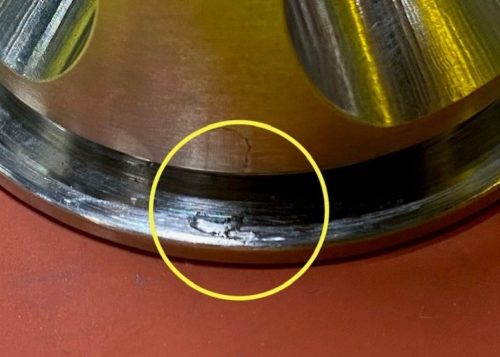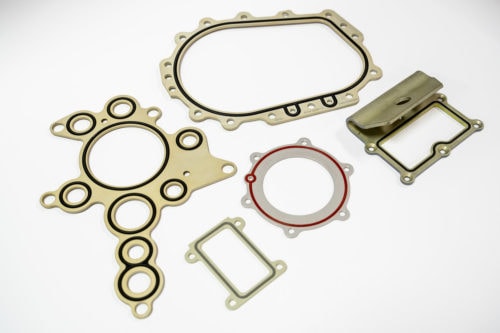Could Your Application Benefit from Bonded Plate Seals?
The terms composite seals, plate seals, and bonded plate seals are often used to describe the same thing: a component made by chemically bonding an elastomer (rubber) to a metal plate in an optimum sealing geometry.
At Micro-Tronics, we offer in-house rubber-to-metal bonding services for metal components with a seal bead, such as seal plates. Typically, but not exclusively, we bond elastomers to machined aluminum to make bonded plate seals.
Bonded plate seals are durable and long-lasting. They’re a great alternative to o-rings and gaskets. Are they right for your next project?
Bonded Plate Seals: An Alternative to O-Rings and Gaskets
While plate seals serve the same purpose as o-rings and rubber gaskets, they are often a better alternative to both. Standard o-rings, which are practical in many mechanical applications, have to be handled carefully. Because they are simply set in place, o-rings can easily become dislodged or fall out during manufacturing or installation and become damaged causing leakage. Large o-rings are especially unwieldy—imagine trying to place an o-ring on an assembly with a 20-inch diameter!
Die-cut rubber gaskets are also risky: they can break down under extreme pressure or if a part experiences too much wear and/or fatigue. If you’re already going through the molding process to make a custom rubber gasket, why not reinforce the gasket and bond it to a metal component?
O-rings and gaskets are both more challenging to install than plate seals. Especially at scale, it’s time-consuming and difficult to set these components in place correctly. If they aren’t positioned properly, o-rings and rubber gaskets can get pinched and fail during use. And that means greater liability and more downtime during production or repair and overhaul.
5 Design Considerations for Bonded Plate Seals
Bonded plate seals offer more design flexibility than standard o-rings and gaskets. When you think about designing a bonded plate seal, consider these five factors:
- Material selection. Instead of working with standardized materials, we can formulate elastomer products molded to your custom specifications.
- Customizable shape. Bonded plate seals aren’t restricted to circles of different sizes like o-rings. We can work with customized geometries, including odd shapes.
- Sealing lip design. In some cases, the sealing surface of a bonded seal plate will look similar to an o-ring. However, we can incorporate features such as a double hump instead of the single hump o-rings provide. Applications that experience higher pressure may require a double hump design feature. Other designs include hemisphere, multilip, labrynth, wave, etc.
- Mechanical locks. We recommend designing for mechanical locks when applicable for double sided seals. Mechanical locks are essentially webs that run through the metal to connect with and reinforce the bond to the elastomer. For dual-sided bonded plate seals, a mechanical lock provides a backstop for the adhesive, further securing the seal.
- Seal bead customization. Seal beads must be extremely precise to control the flow of fluids and air within a part, and we can customize seal beads to your project’s unique specifications. We can apply double or even triple beads to meet your requirements. We can also add a depression on either side of the seal bead as needed, a capability that isn’t available for o-rings.
Micro-Tronics Makes Bonded Plate Seals In-House
Leveraging the principles of vertical integration, Micro-Tronics manufactures high-quality bonded plate seals quickly and cost-effectively.
Our integrated team of experts can make your bonded seal plates entirely in-house. We’ll work with you on your design and material selection, machine the metal plates, and chemically bond them to the elastomer seals, all under one roof.

Damaged part with burr
To expedite production, we stock numerous metal and elastomer materials used by a variety of industries, including aerospace and defense. We can even run fluid compatibility tests to confirm your seals are an environmental match.
When possible, we prefer to own the entire manufacturing process to ensure bonded plate seals meet our stringent quality standards. Even tiny burrs can jeopardize the functionality of a bonded seal, and we’ve often run into challenges with machined parts that weren’t fully prepared for elastomer seals and assembly. This also accounts for stacked tolerances of metal and elastomer for final part dimensions.
When we can machine the parts from scratch and own the entire process, we can deliver customers a higher quality product, more consistent outcomes, and a reliable lead time.
If you’re interested in bonded plate seals for your next application, make sure you enlist an expert to guide you through the manufacturing process. Want to learn more about working with Micro-Tronics? Submit an RFQ to get started, and our team will respond promptly.





